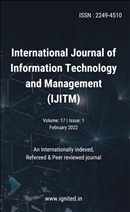A Study on Profitable of Futures with the Reference to SBI Bank
Main Article Content
Authors
Abstract
New instruments and reengineering of the financial system were introduced in India in 1992 as apart of economic market reforms. One among them was that the growth and innovation were slow infamiliarizing Securities. The formation and expansion of derivatives in Indian markets are moderately alatest spectacle. Subsequently its commencement in June 2000, the products need devises displayedepidemicaugmentation in magnitude and the number of bartered conventional agreements. Significanttermend product guides an expansive class of financial tools that specifically possess options andfutures. These mechanisms emanate their significance from the underlying asset's price and otherrelated variables. They accomplish not having a value of their own and originate their importance fromthe prerogative they give to their proprietors to own some additional financial support or safety. Thepresent study is deliberate in examining the financial results obeying SBI Bank Ltd.
Downloads
Download data is not yet available.
Article Details
Section
Articles
References
- Dr Naveen Prasadula, A Study of Derivatives Market in India and its Current Position in Global Financial Derivatives Markets, IOSR Journal of Economics and Finance Volume 3, Issue 3. (Mar-Apr. 2021), PP 25-42
- Greeshma Franc, A study on Emerging Trends in Indian Derivative Market, International Research Journal of Engineering and Technology (IRJET) Volume: 06 Issue: 04 | Apr 2019
- Mohammed Rubani, A Study of Derivative Market in India, International Journal of Business Administration and Management. ISSN 2278-3660 Volume 7, Number 1 (2017).
- A Vashishtha, S Kumar ,Development of financial derivatives market in India-a case study
- , International Research Journal of Finance, International Research Journal of Finance and Economics, Volume 37, Issue 37,Pages 15-29
- K. Soniya, A Study on Financial Derivatives (Future & Options) with Special Reference to ICICI & SBI,International Journal of Commerce & Business Studies Volume 1, Issue 2, October-December, 2013

